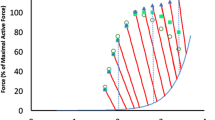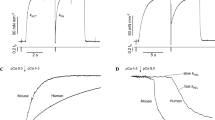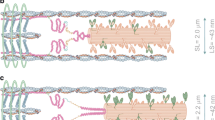Summary
In skinned skeletal muscle fibers and skinned preparations of myocardium or smooth muscle, for all conditions studied, the length traces during isotonic shortening are always found to be significantly curved. It is demonstrated that the observed curvature is not simply due to inhomogeneities on the sarcomere level in striated muscle, damaged ends of the preparations, double overlap and collision of filaments, or depletion of MgATP during the period of isotonic shortening. It is shown that the velocity of shortening can be described by an exponential function: v=vi exp (-b[SLi-SL]) with SLi: sarcomere length at the start of the release; SL: sarcomere length during isotonic shortening. Thus, instantaneous shortening velocity (v) is determined by two parameters: vi, the initial shortening velocity for SL=SLi, and b, a constant characterizing the decrease in velocity during isotonic shortening. Factors which affect isotonic shortening can do this by affecting vi, or by changing b, or both. Therefore, when analysing the effects of interventions which affect instantaneous shortening velocity, these two possibilities have to be distinguished. Since curvature of the length traces might be caused by noncrossbridge components, only vi, the initial speed of shortening, is a parameter which directly reflects kinetics of the cross-bridge cycle while instantaneous speed of shortening might also be affected by noncrossbridge factors.
Analysing isotonic shortening in terms of vi and b, the effects of ionic strength, free Ca++ concentration, MgATP/MgADP ratio and temperature on unloaded isotonic shortening have been studied. For the conditions used, it can be shown that ionic strength and free Ca++ concentration only affect b without significant effect on vi, whereas MgATP/MgADP ratio and temperature affect both vi and b. This means that of these factors only MgATP/MgADP ratio and temperature affect the crossbridge kinetics which determine the maximum speed of shortening while ionic strength and free Ca++ concentration have no such effect within the experimental error.
Similar content being viewed by others
References
Arner A (1982) Mechanical characteristics of chemically skinned guinea-pig Taenia coli. Pflüg Arch 395:277–284
Brenner B (1980) Effect of free sarcoplasmic Ca2+ concentration on maximum unloaded shortening velocity: measurements on single glycerinated rabbit psoas muscle fibres. J Musc Res Cell Mot 1:409–428
Brenner B (1980) Calcium activation and maximum unloaded shortening velocity. Investigations on glycerinated skeletal and heart muscle preparations. Basic Res Cardiol 75:40–46
Brenner B (1983) Technique for stabilizing the striation pattern in maximally calcium-activated skinned rabbit psoas fibers. Biophys J 41:99–102
Eastwood AB, Wood DS, Bock KL, Sorenson MM (1979) Chemically skinned mammalian skeletal muscle. I. The structure of skinned rabbit psoas. Tissue & Cell 11:553–566
Ebrecht G, Rupp H, Jacob R (1982) Alterations of mechanical parameters in chemically skinned preparations of rat myocardium as a function of isoenzyme pattern of myosin. Basic Res Cardiol 77:221–234
Edman KAP, Hwang JC (1977) The force-velocity relationship in vertebrate muscle fibers at varied tonicity of the extracellular medium. J Physiol Lond 269:255–272
Eisenberg E, Hill TL (1978) A cross-bridge model of muscular contraction. Prog Biophys Mol Biol 33:55–82
Eisenberg E, Greene LE (1980) The relation of muscle biochemistry to muscle physiology. Ann Rev Physiol 42:293–309
Fabiato A, Fabiato F (1979) Calculator programs for computing the composition of the solutions containing multiple metals and ligands used for experiments in skinned muscle cells. J Physiol Paris 75:463–505
Ferenczi MA, Goldman YE, Simmons RM (1984) The dependence of force and shortening velocity on substrate concentration in skinned muscle fibers from Rana temporaria. J Physiol Lond 350:519–543
Gulati J, Podolsky RJ (1981) Isotonic contraction of skinned muscle fibers on a slow time base. J Gen Physiol 78:233–257
Hellstrand P, Johansson B, Ringberg A (1972) Influence of extracellular calcium on isometric force and velocity of shortening in depolarized venous smooth muscle. Acta Physiol Scand 84:528–537
Herzig JW, Rüegg JC (1980) Investigations on glycerinated cardiac muscle fibres in relation to the problem of regulation of cardiac contractility-effects of Ca++ and c-AMP. Basic Res Cardiol 75:26–33
Hill AV (1970) First and last experiments in muscle mechanics. University Press, Cambridge
Huxley AF (1957) Molecular structure and theories of contraction. Prog Biophys Molec Biol 7:255–318
Huxley AF, Julian FJ (1965) Speed of unloaded shortening in frog striated muscle fibres. J Physiol Lond 177:60P
Huxley AF, Simmons RM (1971) Proposed mechanism of force generation in striated muscle. Nature Lond 233:533–538
Julian FJ (1971) The effect of calcium on the force-velocity relation of briefly glycerinated frog muscle fibers. J Physiol Lond 218:117–145
Julian FJ, Moss RL (1981) Effects of calcium and ionic strength on shortening velocity and tension development in frog skinned muscle fibers. J Physiol Lond 311:179–199
Maughan DW, Low ES, Alpert NR (1978) Isometric force development, isotonic shortening, and elasticity measurements from Ca2+-activated ventricular muscle of the guinea-pig. J Gen Physiol 71:431–451
Moss RL (1982) The effect of calcium on the maximum velocity of shortening in skinned skeletal muscle fibres of the rabbit. J Muscle Res Cell Mot 3:295–311
Pagani ED, Julian FJ (1984) Rabbit papillary muscle myosin isozymes and the velocity of muscle shortening. Circ Res 54:586–594
Paul RJ, Deorman G, Zeugner C, Rüegg JC (1983) The dependence of unloaded shortening velocity on Ca++, calmodulin, and duration of contraction in “chemically skinned” smooth muscle. Circ Res 53:342–351
Podolsky RJ, Teichholz LE (1970) The relation between calcium and contraction kinetics in skinned muscle fibers. J Physiol Lond 211:19–35
Wang K, Ramirez-Mitchell R (1983) A network of transverse and longitudinal intermediate filaments is associated with sarcomeres of adult vertebrate skeletal muscle. J Cell Biol 96:562–570
Wise RM, Rodinone JF, Briggs FN (1971) Effect of calcium on force-velocity characteristics of glycerinated skeletal muscle. Am J Physiol 221:973–979
Author information
Authors and Affiliations
Additional information
Dedicated to Prof. R. Jacob on the occasion of his 60th birthday.
Supported by the Deutsche Forschungsgemeinschaft: Br 849/1-1.
Rights and permissions
About this article
Cite this article
Brenner, B. The necessity of using two parameters to describe isotonic shortening velocity of muscle tissues: the effect of various interventions upon initial shortening velocity (vi) and curvature (b). Basic Res Cardiol 81, 54–69 (1986). https://doi.org/10.1007/BF01907427
Received:
Issue Date:
DOI: https://doi.org/10.1007/BF01907427




